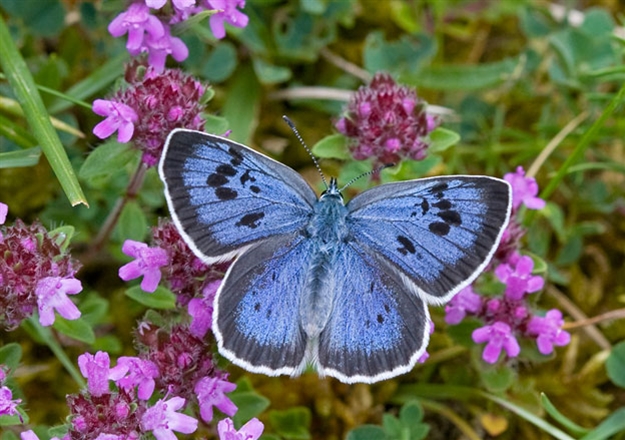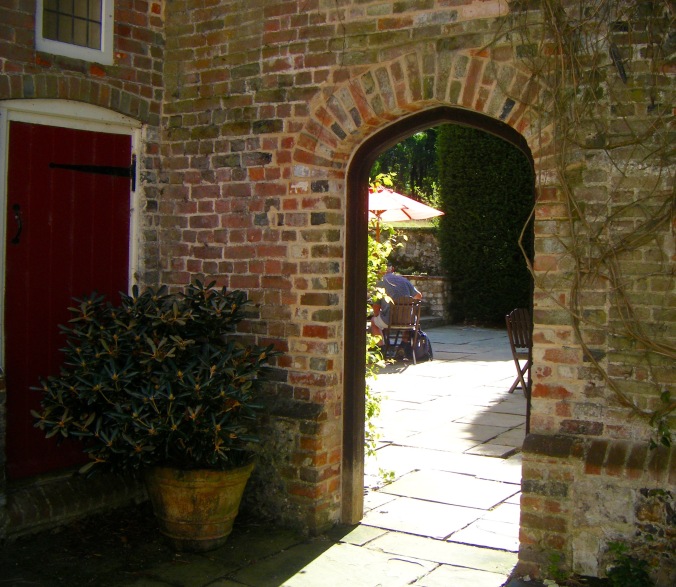‘I went up to the Great House between 3 and 4, and dawdled away an hour very comfortably’
Wrote Jane Austen in 1814. She was referring to Chawton House built by the Knight family in 1580 and centuries later inherited by her brother Edward Austen . So when it opened for the National Garden Scheme on the sunny Bank Holiday Sunday last month, I too went and dawdled away an hour very comfortably.

We were fortunate to be just in time to join a tour with Garden Manager Andrew Bentley and, with map in hand we began on the South Lawn.

Set in the beautiful Hampshire countryside we looked out on the open views across the estate while Andrew explained the popularity of this Brownian English Landscape-style during the 18th century, when the view would have been similar and a ha-ha would have kept the grazing animals in sight but away from the garden.

We returned to the house and onto the Library Terrace. Built during the time of Montagu Knight in the early 19th century it is attributed to Sir Edwin Lutyens, a friend and frequent visitor.

Andrew has begun to plant a white garden here. Influenced by Vita Sackville-West’s famous white garden at Sissinghurst Castle, he felt it appropriate not just because of its beauty but because her mother had an affair with Lutyens while staying at Chawton.

The inlaid pattern at the top of the steps is reminiscent of the manner of the Arts and Crafts Movement, and acts as a turning circle directing us to the left.

We gradually climb the Serpentine gravel path passing through bushes laden with autumnal berries,

and continuing along the Upper Terrace.

Here we can look back down towards the house which, having fallen into disrepair has been restored and has become a library, the home of a unique collection of women’s literature in English during the period 1600-1830.

‘Edward is very well and enjoys himself as well as any Hampshire born Austen can desire. He talks of making a new Garden…’
Perhaps it is the Walled Garden to which Jane is referring. Situated at the highest point of the site it has an open area known as the auditorium which has been converted to a rose garden and contains 48 varieties of heritage roses and two mulberry trees. Right now they are hard to see as the self-seeded verbena bonariensis has taken over.

Decorative wrought-iron gates lead from the auditorium into the Walled Garden.

In the Austen’s day, there were 17 gardeners here. Now there is less manpower available. The Walled Garden is divided into three areas, a productive vegetable area, an orchard and a herb garden.

Twenty six varieties of apple are grown with some of the trees being quite mature.

The Herb Garden was designed by Andrew himself, the exercise being part of his interview for the job which he was offered and took up last year. He was intrigued by a book kept in the Chawton House Library, A Curious Herbal by Elizabeth Blackwell which was published in instalments from 1737-1739, when Blackwell was able to support herself and free her husband from debtors’ prison.

The design consists of four beds divided by concentric circular paths with a seat placed in the central lawn. The quadrants relate to the herbs that cure maladies to the head, chest, skin and digestion.

With the promise that so many herbs are readily available to cure one’s afflictions we can share in the radiancy of the sunflower overlooking the herbs. Andrew then displays his botanical knowledge by giving us a quick lesson on ‘fasciation’ which has occurred on one of the other heads of sunflower (which may drive the reader to the search engine).

The princely sum of £190,000 is needed to restore the former greenhouse which once stood here, the ivy hides the chimney of the boiler house. Over the wall is the gardener’s cottage, occupied until 75 years ago it now no longer houses any gardener.

Edging the central path are the delicate blooms of the rose ‘Pride and Prejudice’ bred by Harkness Roses to celebrate 200 years of the novel published in 1813. Andrew was able to pick a small bouquet on 18th July this year and lay it on Jane’s gravestone in Winchester Cathedral to commemorate the bicentenary of her death.

The Walled Garden took four years to build and sadly Jane did not see its completion. The stone acorns are unusual; less grand than some finials of that era, Andrew suggests that they may just be Edward Austen’s nod to humility.

Opposite the Walled Garden a path leads into the ‘Wilderness’ which we do not take, and unlike Mrs Bertram in Mansfield Park who declared ‘One likes to get out into a shrubbery in fine weather’, we also pass by the shrubbery.

Instead we arrive at the garden’s perimeter where the peaceful parkland has been recently grazed by sheep. It is managed with the help of Natural England and looks perhaps like any other grassland. However, Andrew explains that it is essential to ensure that the correct species of grasses and wild thyme are maintained which support a population of red ants. The Large Blue butterflies feed off the wild thyme where they lay their eggs. The red ants make tussocks in the grass in which they bury the hatched larvae of the Large Blue butterfly and harvest their nectar. In May/June the butterflies hatch out all at once and there is an explosion of fluttering blue butterflies. It is a sight that Andrew has been fortunate to see.

It indeed must be quite a sight and I can only provide a picture taken from the Butterfly Conservation website: http://butterfly-conservation.org/679-899/large-blue.html.

We move on to wander back through the ‘wilderness’ and return to the house along the avenue of Lime trees leading onto the South lawn. Standing just off the lawn is a Black Walnut juglans nigra; not to be confused with the common walnut juglans regia, it is native to North America. The roots contain a growth-inhibiting chemical which prevents many other trees and plants growing near it.

Just to the right is the tower of the parish church which rises above the yew trees in the churchyard,

where the graves of Jane’s mother and sister lie together.

But before leaving I pop back to the house for a little sustenance,

and sharing in that same sentiment as Jane ‘But indeed, I would rather have nothing but tea’, I sit and enjoy it in the sunny courtyard.

A shepherd’s hut, unimpeded by notices of ticket sales, upcoming events or ice cream adverts, stands simply at the entrance as a reminder that this was once a working farm.

It is a charmingly unspoilt site. Garden history, botany and ecology have been woven into this delightful and informative tour. The garden is open again for the NGS on Sunday 22nd October and I assure you that the garden tour costing just £1.00 is worth every penny.
——-70——-
This looks like a beautiful place to visit! Love your photos of the garden, so colourful!
LikeLike
I have always wanted to visit Chawton House, will definitely make it one for the diary in 2018! Thank you for sharing.
LikeLike